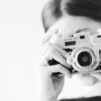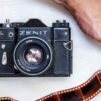
There is a common misconception that books on photography have little educational value and are mostly means of massaging the egos of their authors. In reality, there are hundreds of fantastic literary works that can help you compose a perfect frame, eliminate posing mistakes, and enhance your perception of colors. I recommend the following literature for beginners, but experienced photographers will benefit from it too.
How To Pose The Model by William Mortensen

William Mortensen worked in Hollywood in the 1920s, where, among other things, he specialized in actor photoshoots. You won’t find clear instructions in this book: Mortensen only shows how not to do it. Thus, it provides readers with creative freedom without driving them into a framework of standard rules.
Mortensen contemplates posing problems by addressing the classical canons of fine art. In his opinion, the best way to study the depiction of the human body is to study classical painting, drawing, and sculpture. “Acquaintance with several albums, which contained a lot of advice and discussions on this, gave me the idea of a book where the problems of the plasticity of the human body would be regarded from the standpoint of photography. But, unfortunately, there was too much hypocrisy in these luxurious albums, I think. The instructions were wrong not only in terms of art but also in terms of biology,” he notes.
Mortensen explains the physical and psychological aspects of working with a model. He explains how to choose a hairstyle, clothing, body position, and adjust the light. To him, the ultimate goal of such preparations is to convey your idea to the model you’re working with.
On Photography by Susan Sontag

On Photography is the book that made the American writer Susan Sontag famous. In her essays, she reflects on the meaning and development of photography. The main focus of this book is “some of the aesthetic and moral problems that arise in connection with the ubiquity of photographic images.”
Such omnipresence concerns the author: “By duplicating our already cluttered world with its images, photography allows us to believe that the world is more accessible than it really is. The desire to confirm the reality and expand the experience with photography is the aesthetic consumerism that everyone is infected with today. Industrial societies put their citizens in pictures,” she writes. Sontag’s ideas provide insight into the role of photography in today’s information society.
The researcher also draws attention to the conceptual and aesthetic side of photography: “An acute need for beauty, unwillingness to explore what is under the surface, intoxication with the bodily world – all these components of erotic feelings are manifested in the pleasure we get from photography. But this pleasure has a downside, opposite to freedom. So it would not be an exaggeration to say that people develop photo dependence: the need to turn their experience into a way of seeing.”
Ways of Seeing by John Berger

This book is a collection of essays by the English critic John Berger. They are devoted to the problems of visual art. For example, Burger explains how photography has replaced portrait and why it cannot be considered fine art.
“Each photograph is a means of checking, confirming, and building a self-sufficient judgment about reality,” he writes. As an adherent of Marxism, Berger points out the importance of photography in the ideological struggle. He says: “Hence the need for us to understand the weapons that we can use and which can be used against us.”
In his essays, Berger analyzes how photography can contribute to the emergence of certain moods in society, create myths, or, conversely, destroy them. So, he compares the famous painting by Rembrandt, The Anatomy Lesson of Dr. Nicolaes Tulp, with a photo of the corpse of Che Guevara. “These two images have a similar function: both are intended to show a formal, objective examination of a corpse. Moreover, both are intended to demonstrate something by depicting the dead: the former – the progress of science, the latter – a political warning,” writes Berger, thus confirming his idea of the ideological significance of photography.
Autobiography by Helmut Newton

The great photographer Helmut Newton tells the story of his Berlin childhood, his youth in colonial Singapore, and his travels in Australia, America, and Europe. One after another, Newton tells fascinating stories about his encounters with photographers, editors of fashion magazines, and celebrities of the time.
Newton explains why he never did studio photography, loved to shoot mannequins, hired real paparazzi to pose with the model, and used the red-eye effect. The photographer also tells what works influenced him. Among them are the books by Arthur Schnitzler and Stefan Zweig, as well as Leni Riefenstahl’s movies.
The Eye of the Beholder
A picture may be worth a thousand words, but the thought process behind its creation is as valuable for those who want to master the subtle art of capturing reality. The books listed in this article, besides providing great food for thought, will enrich your arsenal of techniques and inspire you to strive for perfection.





